Physical Address
304 North Cardinal St.
Dorchester Center, MA 02124
The synovium is one of the more recent phylogenetic developments of the vertebrate locomotor system, with the first synovial joints appearing in the piscine jaw of ancestors of the modern lungfish. Embryologically, the synovium is derived from specialized mesoderm termed interzonal mesenchyme, which differentiates from the primitive mesenchyme that lies between and connects the developing mobile cartilaginous anlage of the skeleton ( Fig. 13.1 ). In a specific sequence controlled genetically, the mesenchyme around the joint cavity subsequently cavitates and forms the joint space and synovial membrane. The synovium helps generate synovial fluid, which nourishes the articular cartilage and helps reduce the friction associated with articulation. It also has the capacity to remove small particles from the joint space. Tumors of the synovium can be divided into those that are primary or arise de novo within the joint and those that are secondary and access the joint by invading from neighboring bones and soft tissues or by spreading from distant sites via the vascular system. Primary joint neoplasms are more common than secondary and tend to recapitulate the phenotype of tissues that normally construct the joint, namely synovium, fat, blood vessels, fibrous tissue, and cartilage. Regardless of the histologic type, benign variants greatly outnumber their malignant counterparts, and as a group, these tumors tend to develop in the synovium, not the other periarticular structures.
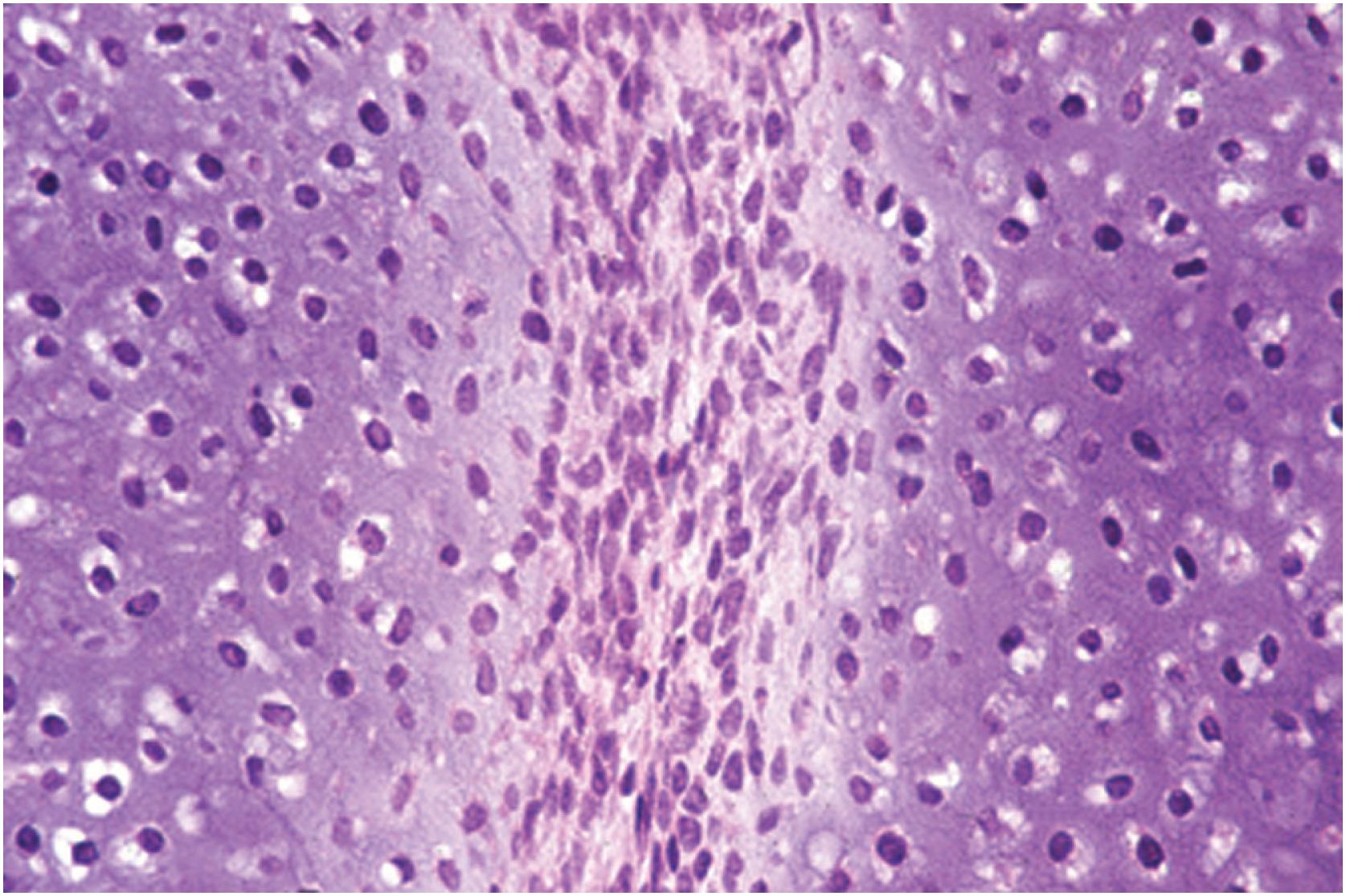
The synovial intima is composed of two to three layers of specialized connective tissue cells named synoviocytes that form the lining of joints, tendons, and bursae. These cells overlay loose connective tissue that contains the variable elements of fat, collagen, and blood vessels. By light microscopy, quiescent synoviocytes are relatively indistinct, appearing as flattened oval dark staining nuclei with indistinct cytoplasmic borders ( Fig. 13.2 ). However, when they are stimulated, as in reaction to some form of injury, they enlarge and acquire abundant eosinophilic cytoplasm and have a more epithelioid morphology ( Fig. 13.3 ). Although indistinguishable by light microscopy, ultrastructurally and molecularly, intimal synoviocytes lining the luminal aspect of the synovial cavity comprise two distinct cell populations: specialized synovial intimal fibroblasts and macrophages. Synovial intimal fibroblasts, traditionally termed B cells (or fibroblast-like synoviocytes), are responsible for synovial fluid production, secreting high levels of proteoglycans and hyaluronan. By immunohistochemistry, these cells express CD55. Ultrastructurally, synovial intimal fibroblasts have ovoid nuclei, inconspicuous nucleoli, and long cytoplasmic processes that radiate in a tendril-like fashion from the cell body. The cytoplasmic processes contain flattened endoplasmic reticulum, ribosomes, a well-developed Golgi apparatus, and numerous subplasmalemmal pinocytotic vesicles. Although the processes interdigitate extensively, cell junctions are not present. Synovial intimal macrophages are interspersed with fibroblastic cells and are traditionally termed “A cells.” They are involved in synovial fluid turnover, tissue repair, and immune surveillance in the joint. These specialized macrophages lack cytoplasmic processes, but have short filopodia and harbor occasional lysosomes, as well as a similar complement of cytoplasmic organelles as the intimal fibroblasts. These cells express clusterin, and occasionally desmin and podoplanin.
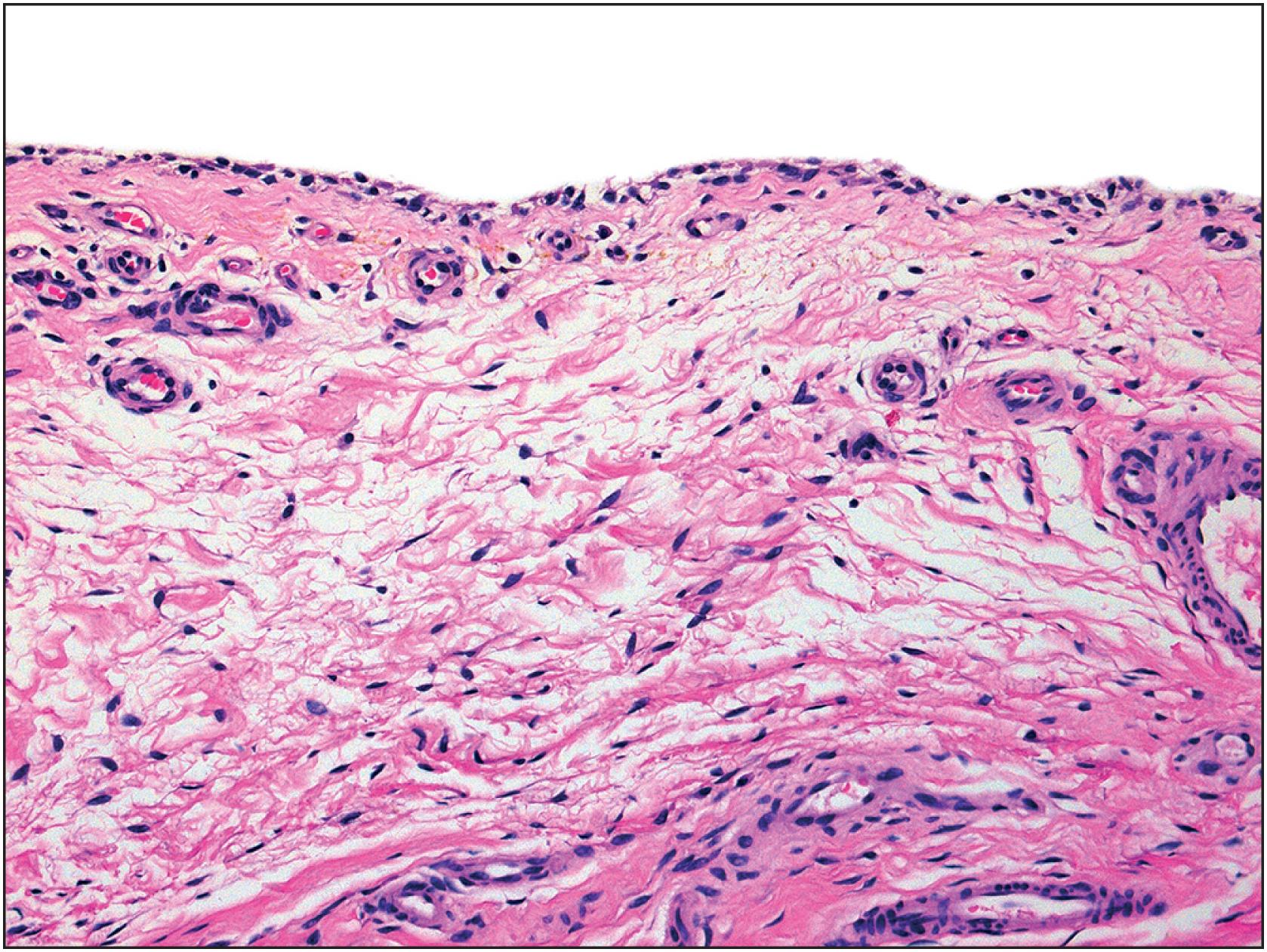
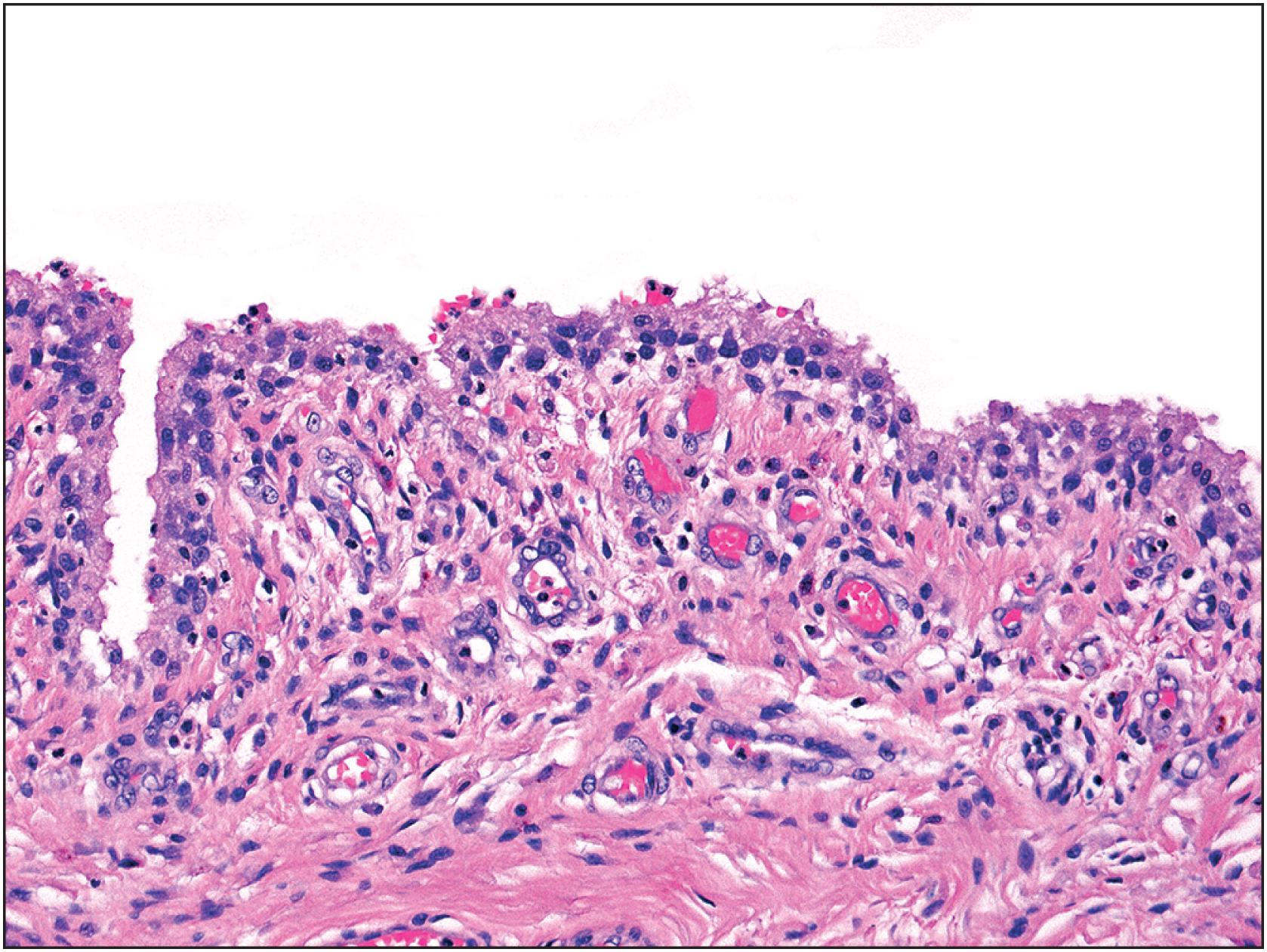
The synovial cells adhere directly to the underlying connective tissue; no basement membrane is present. This absence of basement membrane facilitates the transport of material into and out of the synovial fluid ( Fig. 13.4 ).
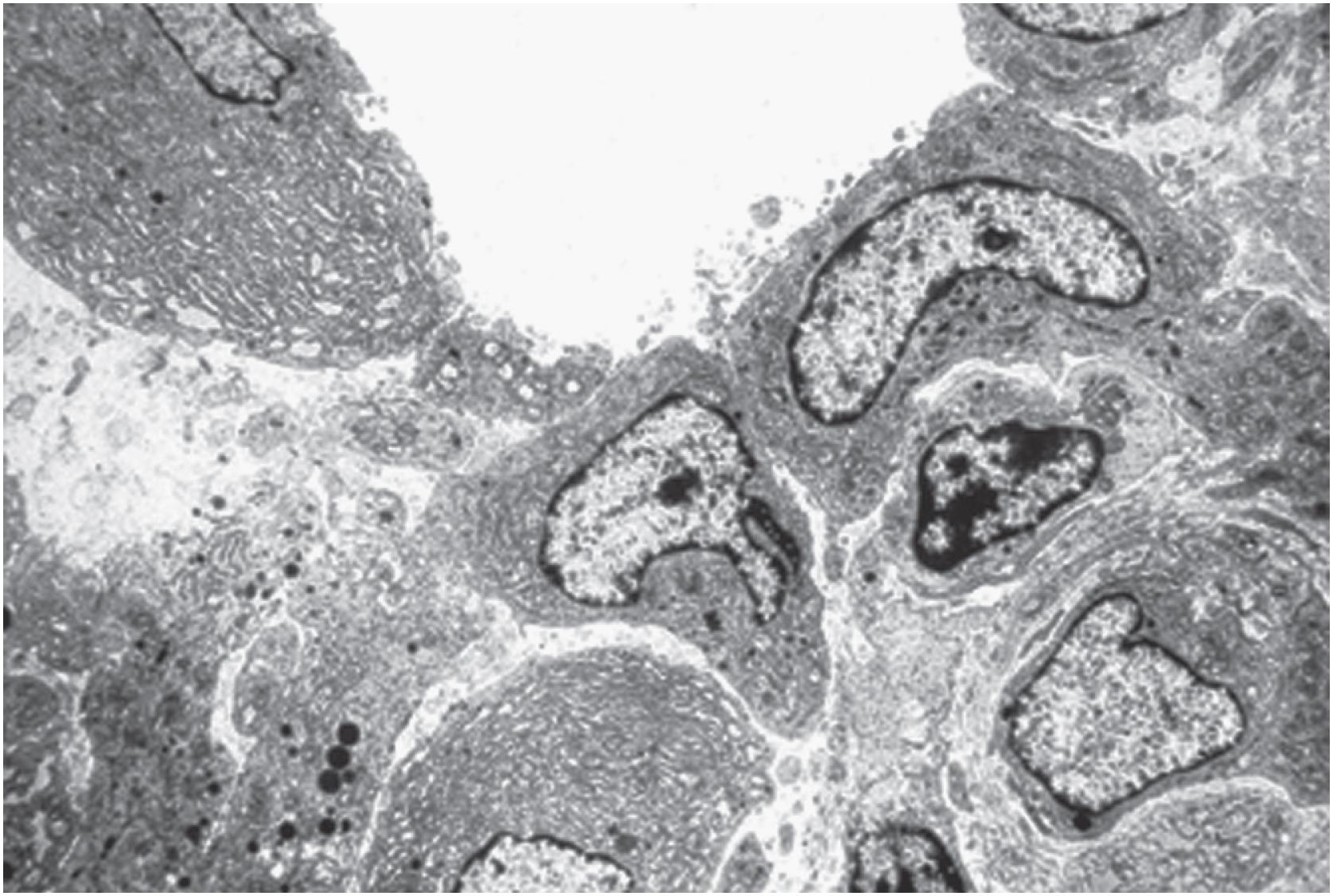
Tenosynovial giant cell tumors (TSGCTs) arise in synovial tissue of joints, tendon sheaths, and bursae, with a neoplastic cell population thought to show synovial macrophage differentiation.
Clinically, TSGCT presents in two distinct forms, localized and diffuse types (formerly termed pigmented villonodular synovitis) (see Box 13.1 ). Localized TSGCT forms a discrete nodule and primarily affects the tenosynovium of the hand, whereas diffuse type TSGCT diffusely involves the synovium, usually of large weight-bearing joints. As yet, no molecular difference has been found that discriminates these two forms. Rarely, tumors may arise at extra-articular or extra- tenosynovial locations.
Neoplasm of the synovial lining of joints, tendon sheaths, and bursae
Two variants, diffuse and localized tenosynovial giant cell tumor, are genetically and histologically similar but show different clinical features, gross presentation, and behavior
Tumors are characterized by rearrangements and truncations of the CSF1 gene resulting in CSF1 overexpression by neoplastic cells
Diffuse TSGCT affects male and female individuals equally and the incidence is highest in the second to fourth decades of life (see Box 13.2 ). Any synovial-lined structure may be affected, although the large joints, especially the knee, are most commonly involved, followed by the hip, ankle, and foot. Rare locations include the temporomandibular joint and the facet joints of the spine. Extra-articular involvement is uncommon and usually arises in tendon sheaths proximal to the ankle and wrist, where it produces a periarticular soft tissue mass. Bursal involvement is rare, but when it does occur, it usually involves popliteal and iliopectineal bursa and the bursa anserina. Tumors are slow growing and typically produce pain, swelling, or limitation of movement of the affected joint. Bilateral or involvement of separate joints has infrequently been reported.
Any synovial joint may be affected; most commonly, diffuse tenosynovial giant cell tumor involves the knee joint
Tumors may arise in extra-articular locations
Male and female sexes are affected with equal frequencies
Most common in the second through fourth decades of life
Symptoms are related to mechanical disruption of the affected joint; typically, pain, swelling, and limitation of movement; rarely, diffuse tenosynovial giant cell tumor may result in erosion of one or more of the bones comprising the articulation
Plain radiographs may show soft tissue mass or bone erosion if present
MRI accurately defines the extent of the lesion and is able to positively identify lipid and iron deposits that are characteristically present
Diffuse tenosynovial giant cell tumor is a locally aggressive tumor which may result in degenerative arthropathy
Tumors have high local recurrence rate (>50%), because diffuse involvement of the synovial membrane makes complete excision difficult
Tumors do not metastasize
Treatment is primarily surgical excision
Targeted CSF1 blockade is an option for patients with symptomatic and unresectable disease
Localized TSGCT may occur at any age but is usually diagnosed in patients between 30 and 50 years of age, and is more common in women (see Box 13.3 ). Localized TSGCT has a tendency to arise in extra-articular locations, and may arise in any synovial sheath; however, those of the hands are preferentially affected, usually close to the interphalangeal joint. In fact, localized TSGCT is the most common soft tissue tumor of the hand. The tumor is slow growing and produces a firm nodule that is usually less than 2.0 cm in diameter.
Localized tenosynovial giant cell tumor is uncommon
Any tendon sheath may be affected; by far the most common site is the tendon sheaths of the digits of the hand
More common in female than male individuals
Adults in the fourth through sixth decades of life most commonly affected
Typically presents as a painless or minimally painful lump in the hand or digits
Usually measures less than 3.0 cm in maximum size
Because of its location in the hands and digits, TSGCT may result in bone erosion of the adjacent small bones
Erosions are usually well defined
Benign condition
Simple local excision usually results in cure
Recurrence occurs in 10% to 20% of patients after incomplete excision
Plain radiographs of diffuse TSGCT are often normal or show only a soft tissue density. Computed tomography (CT) scans and magnetic resonance imaging (MRI) may be helpful in that they can demonstrate the extent of the tumor and presence of intralesional lipid and iron (hemosiderin). A minority of tumors erode into adjacent bones, in which case, multiple well-marginated, subchondral, cyst-like lucencies, or pressure erosions are seen ( Fig. 13.5 ).
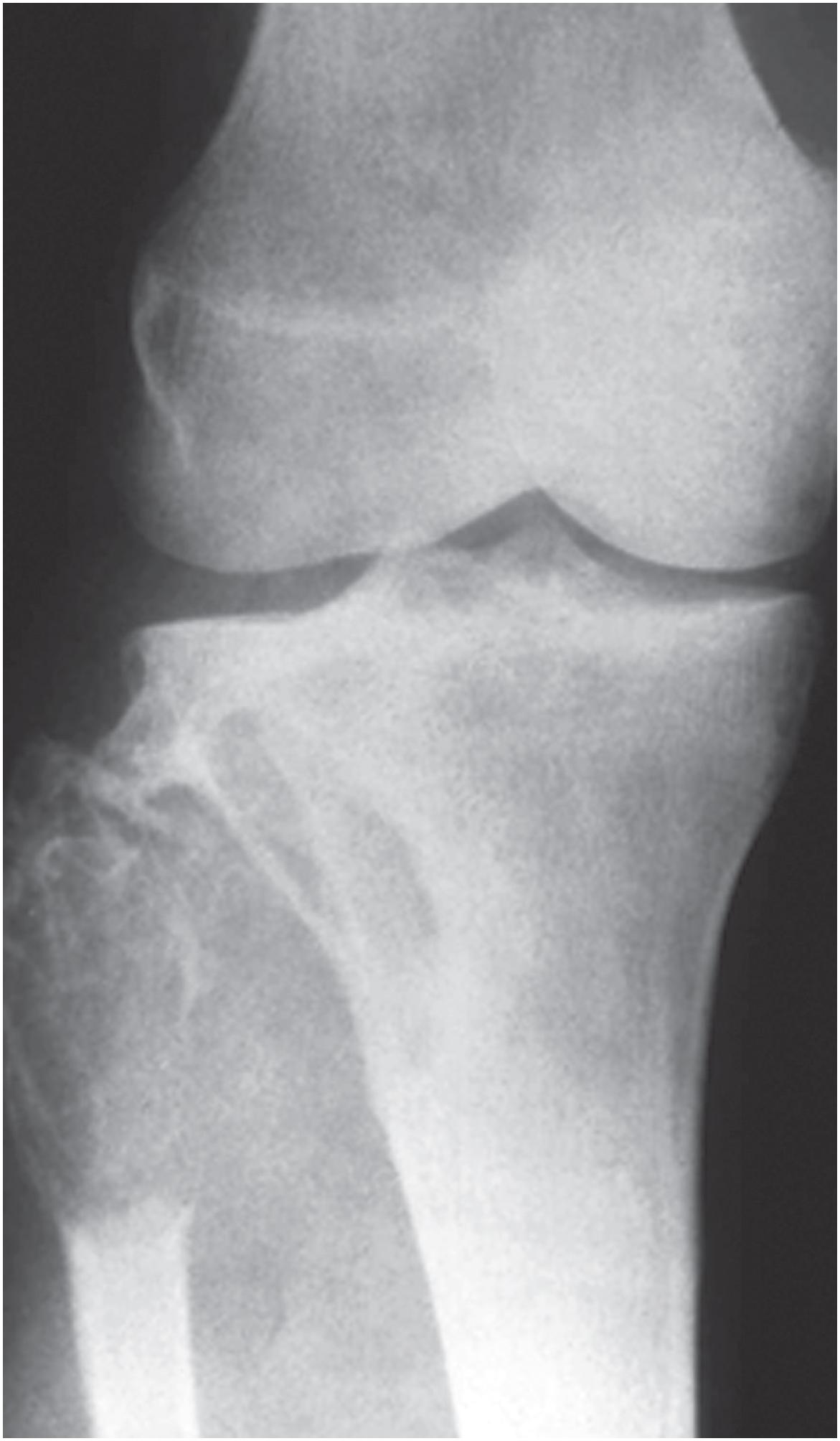
Localized TSGCT appears as a circumscribed soft tissue mass that may be associated with bony erosions of the adjacent bone. The erosions are well defined and have sclerotic margins, and are due to the direct pressure of the lesion on the underlying bone ( Fig. 13.6 ).
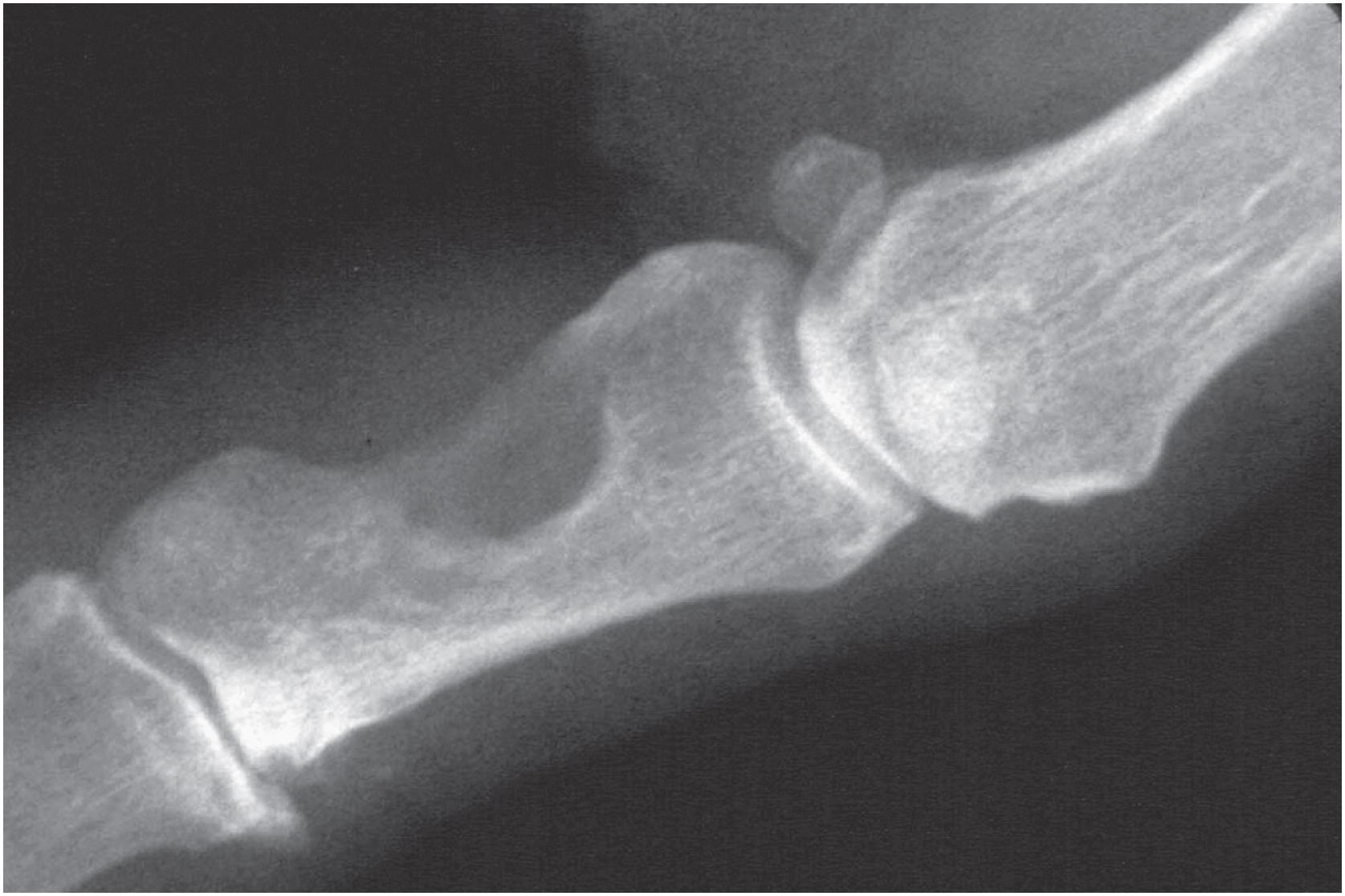
Diffuse TSGCT forms a diffuse villous and nodular red-brown thickening of the synovium and contains finger-like excrescences admixed with 0.5–2.0 cm round nodules. Scattered areas of grossly uninvolved synovium are invariably present. On cross section, the tumor is solid, rusty brown and yellow, with white-grey foci ( Figs 13.7–13.9 ).
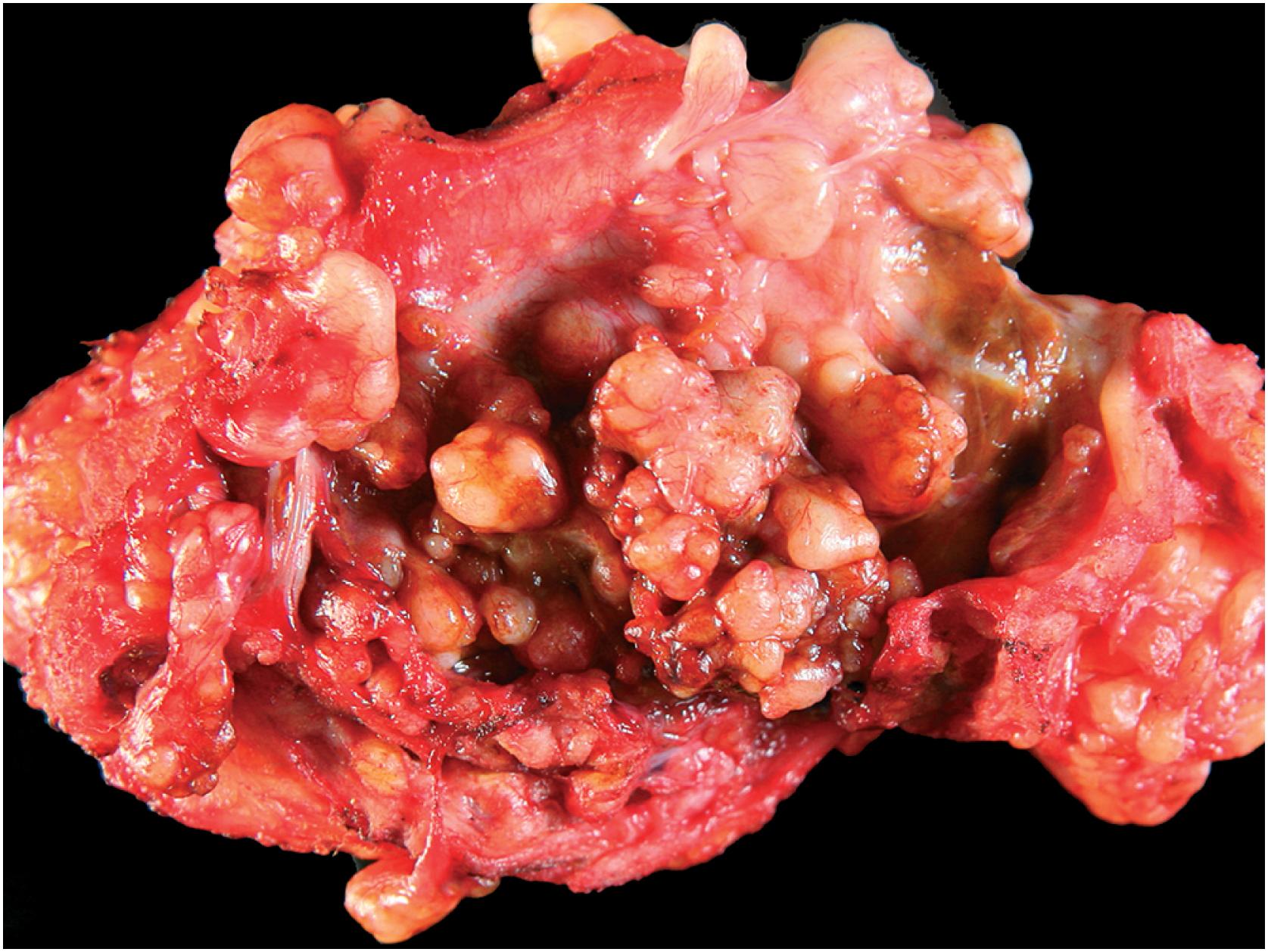
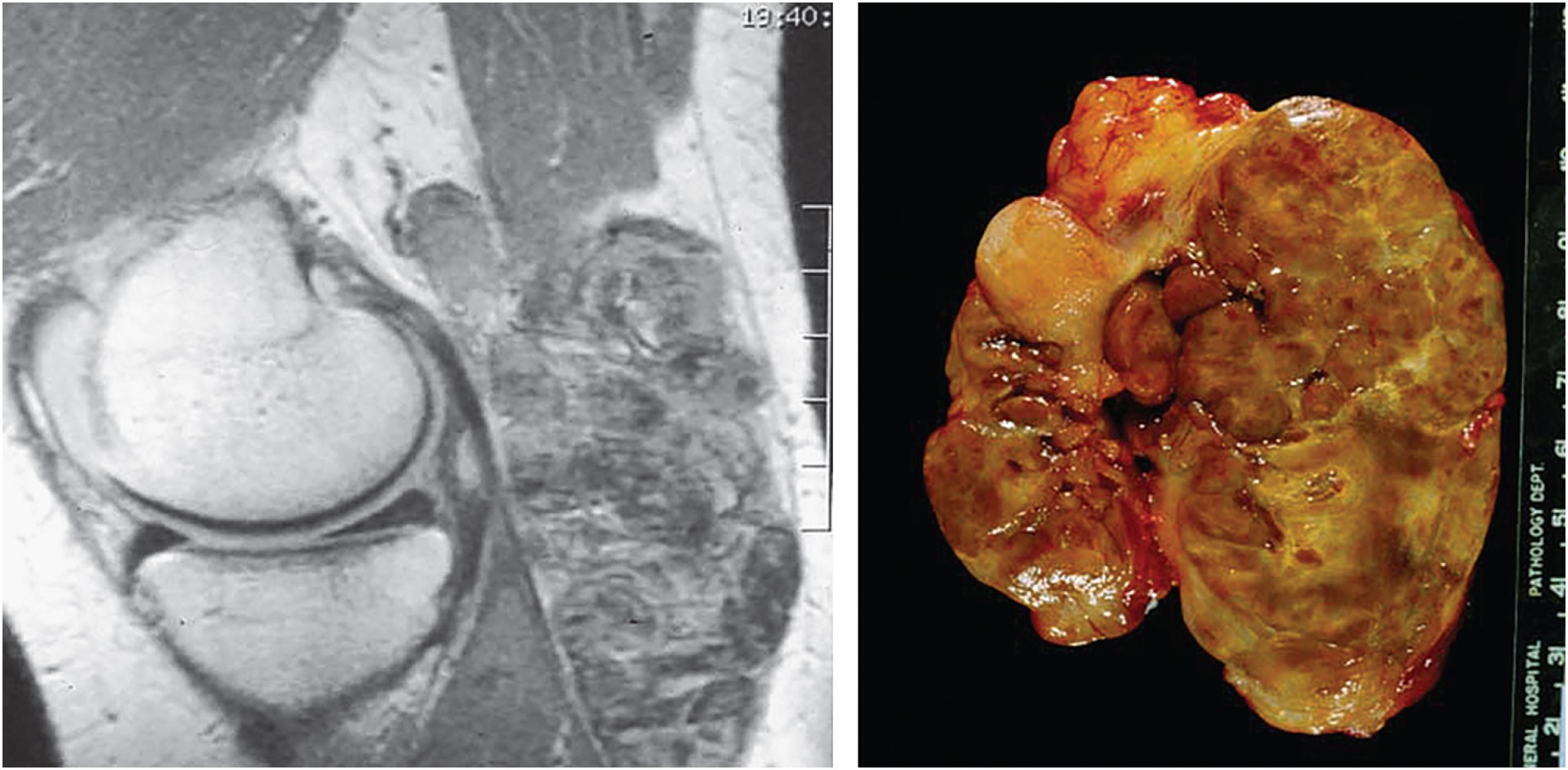
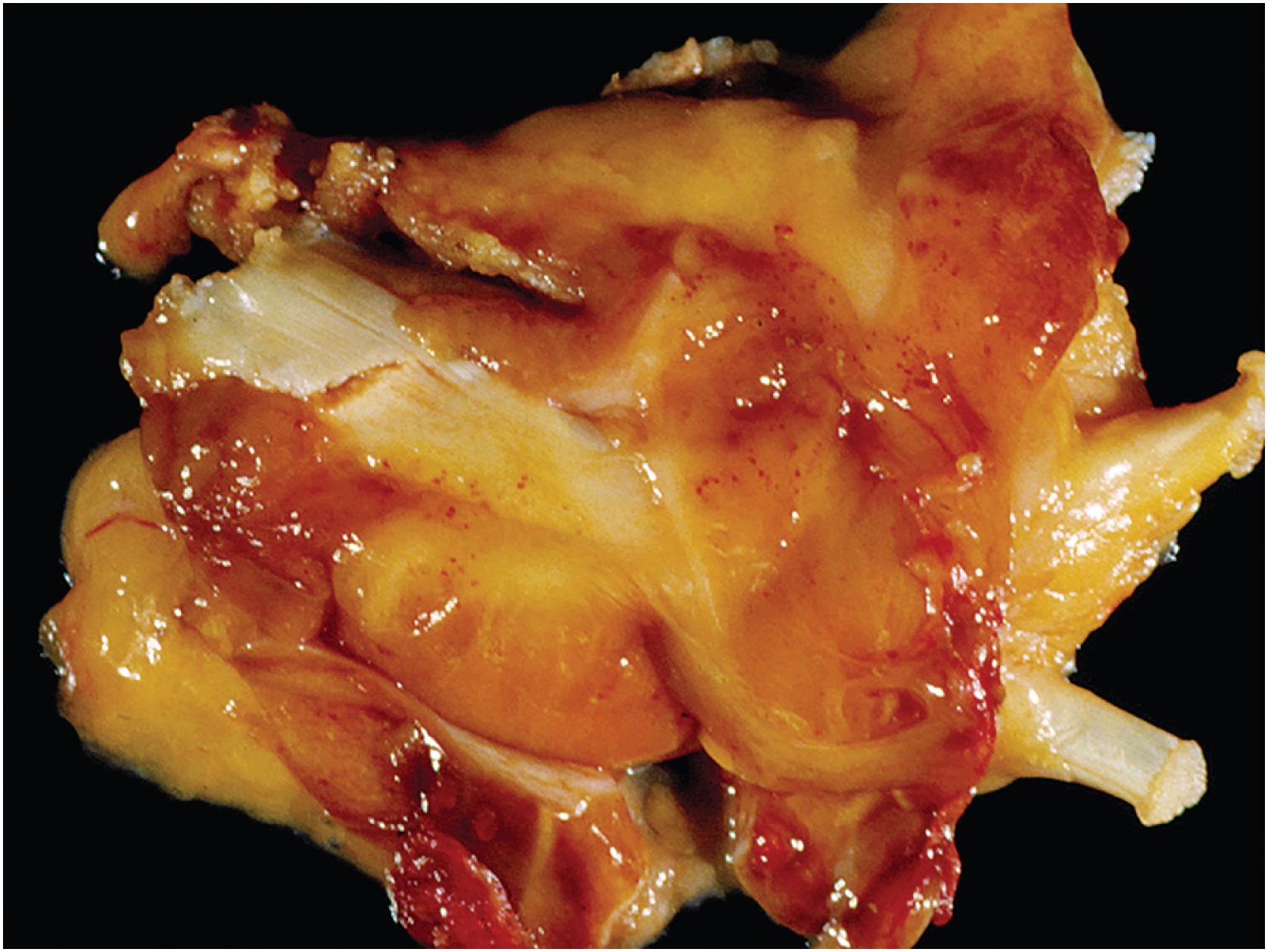
Localized TSGCT is well circumscribed and lobulated. Tumors are usually small, and on cross sections are grey-tan with brown and yellow areas, depending on the amount of hemosiderin and lipid-laden macrophages ( Fig. 13.10 ).
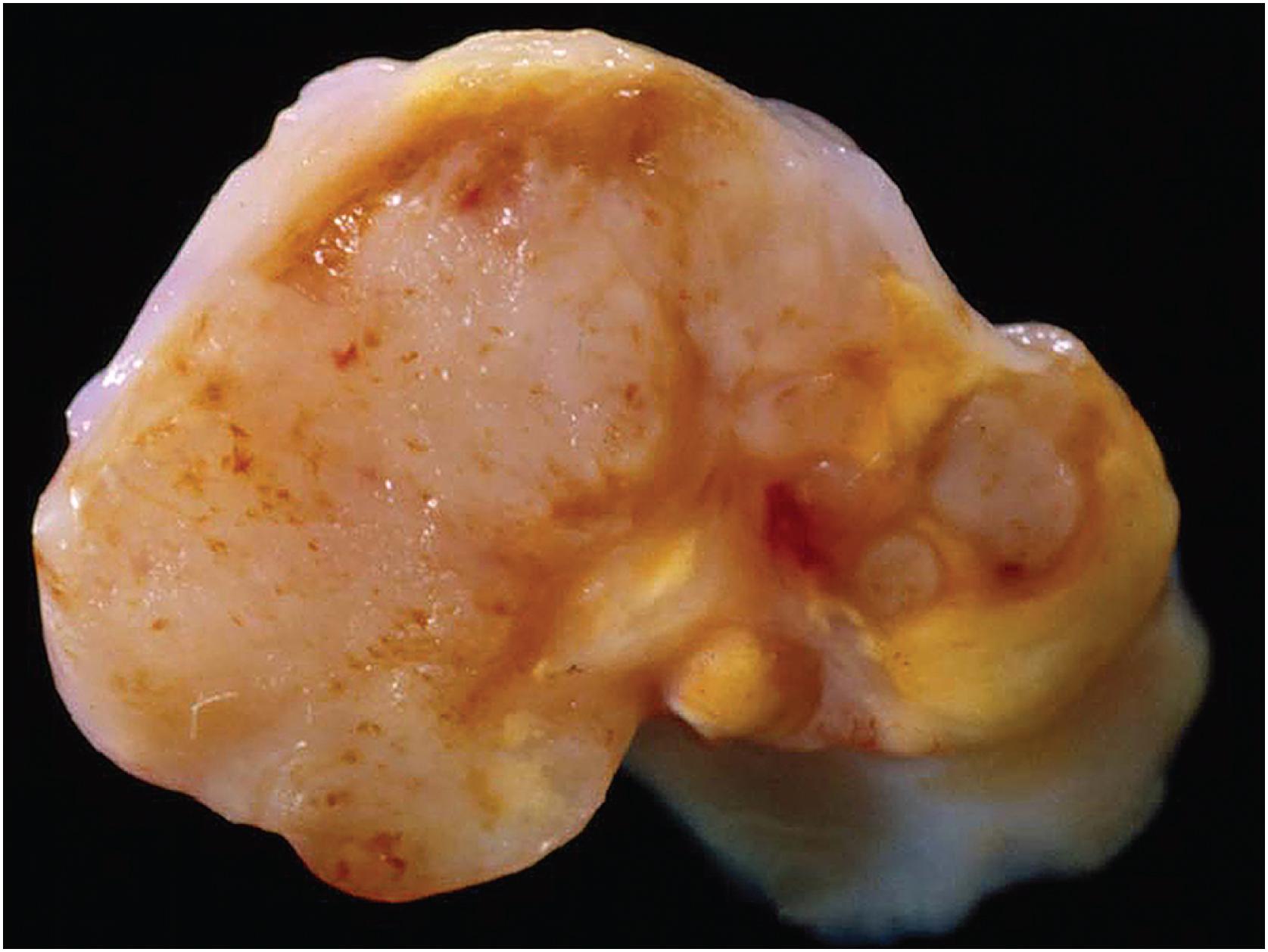
TSGCTs are comprised of a variety of monocyte-derived histiocytic cells, including siderophages, foamy macrophages, multinucleated osteoclast-like giant cells, and distinct types of mononuclear cells. One population of mononuclear cells is smaller, with pale cytoplasm, and irregular nuclei which may be grooved. The second population is larger, with abundant pale eosinophilic cytoplasm, and round or grooved, eccentric nuclei, and may contain a rim of cytoplasmic hemosiderin ( Fig. 13.11 ). Mild nuclear pleomorphism and prominent nucleoli may be present. It is these large mononuclear cells which are thought to be the neoplastic cells. Tumor infiltrating lymphocytes may also be present as scattered cells or small aggregates.
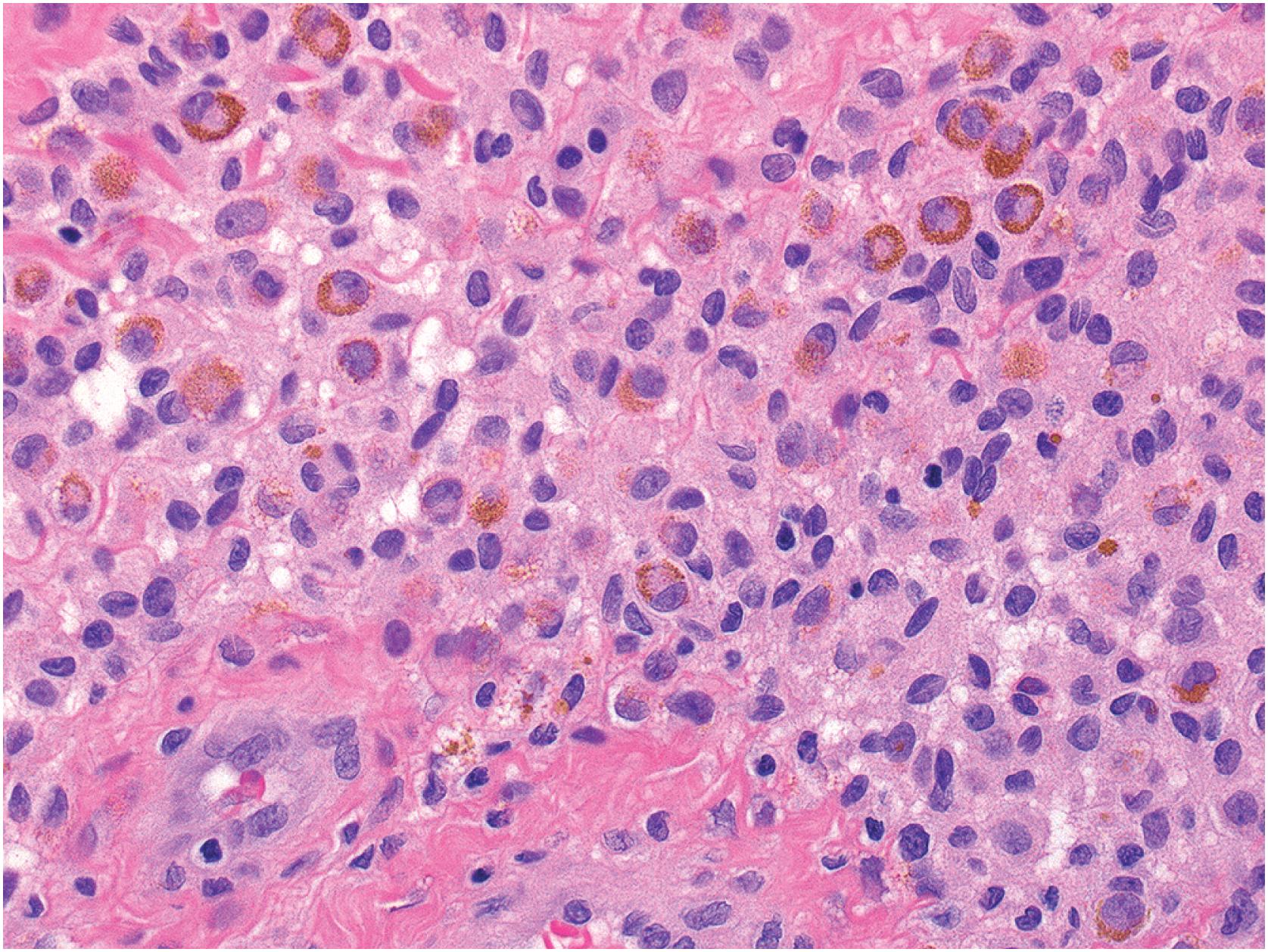
Diffuse TSCGT produces widespread thickening of the synovium, which shows a prominent papillary, villous, and nodular architecture ( Fig. 13.12 ; Box 13.4 ). The preexisting synoviocytes overlie a sheet-like proliferation of lesional cells. The osteoclast-like giant cells are not as numerous as in localized TSGCT, and the collagenous or hyalinized matrix is usually less prominent. Mitotic counts rarely exceed 5 per 10 high-power fields (hpf). Necrosis is rare, and when present, it is usually of the infarct type. In rare instances, the tumor can be completely infarcted. The surface synoviocytes are hyperplastic and may contain phagocytized hemosiderin, mimicking hemosiderotic synovitis.
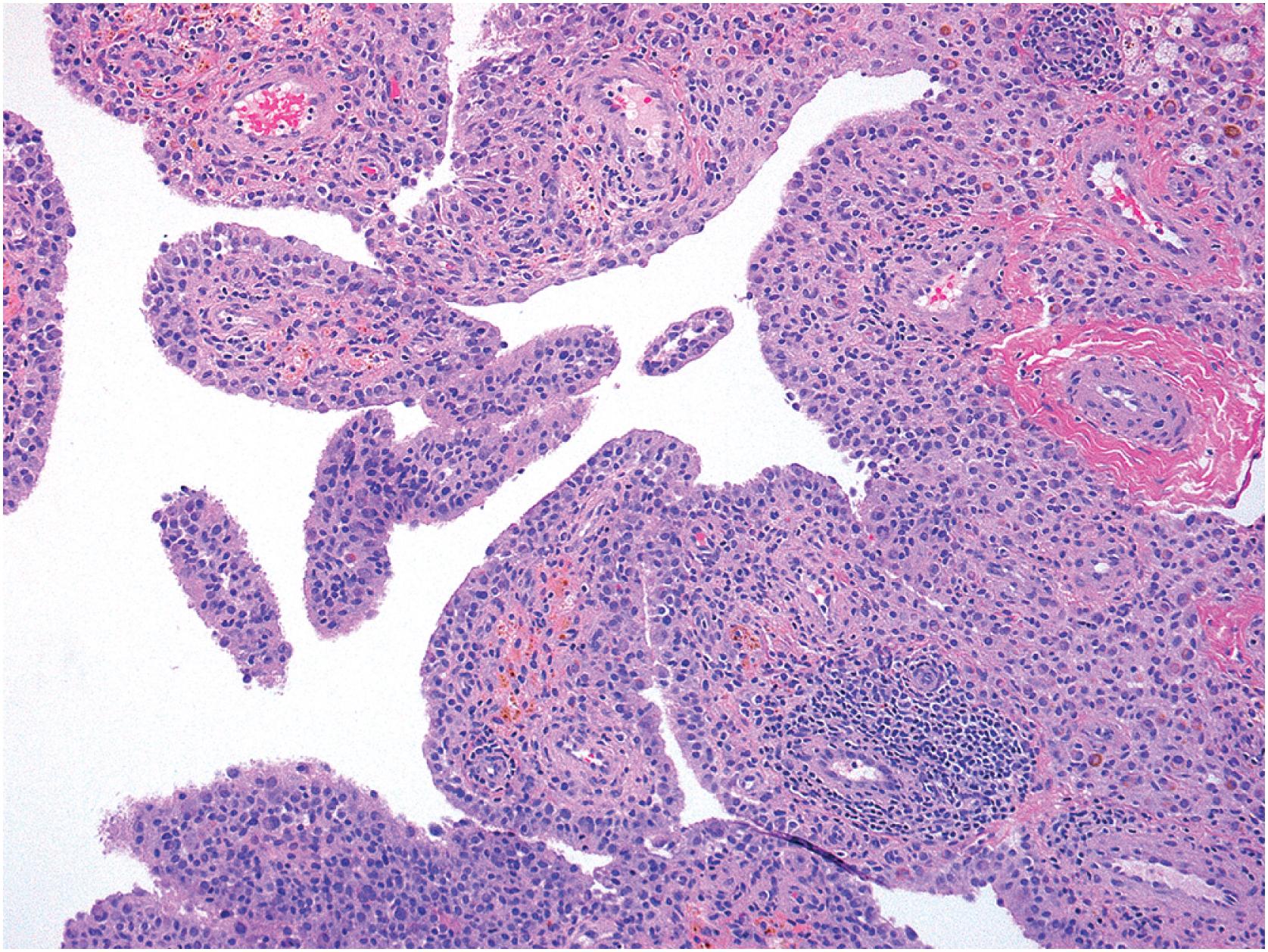
Diffuse thickening of the synovial membrane with villous-like excrescences and nodules up to 2.0 cm
Golden yellow to dark brown
Intact enlarged cuboidal surface synovial cells
Underlying sheets and nodules of epithelioid cells, multinucleated osteoclast-like giant cells, lipid-rich cells, and lymphocytes
Hemosiderin granules within deeper located mononuclear cells
Mitoses usually less than 6/10 high-power fields
Relatively scant intercellular hyalinized collagen
Minor population of neoplastic cells stain for clusterin and podoplanin; desmin may be positive in a subset
Non-neoplastic macrophages stain for CD163 and/or CD68
Multinucleated giant cells stain intensely and strongly for CD68
Localized tenosynovial giant cell tumor
Giant cell tumor of bone with extraosseous extension
Lipoma arborescens
Rhabdomyosarcoma (when strongly desmin-positive and arising in an extra-articular location)
Acral myxoinflammatory fibroblastic sarcoma (can involve or arise from synovium)
Hemosiderotic synovitis
Localized TSGCT is well demarcated, encapsulated, and attached to the adjacent tendon sheath ( Box 13.5 ). Fibrous septa transverse the tumor, giving it a lobulated appearance ( Fig. 13.13 ). In general, while localized TSGCT is identical to the diffuse type, the tumors may contain less hemosiderin and more extracellular collagen. In addition, the number of mononuclear cells, osteoclast-type giant cells, siderophages, and foamy macrophages vary ( Figs 13.14–13.16 ). Mitoses and vascular invasion may be seen, but these features usually do not indicate a more aggressive behavior. Extensive hyalinization and a “pseudoalveolar” pattern of growth may be seen in older examples of localized and diffuse TSGCT.
A well-circumscribed, usually firm nodule
Variegated cut surface with tan, brown, and yellow areas
Similar to diffuse tenosynovial giant cell tumor
Usually no villous projections
Smaller amounts of hemosiderin compared with diffuse tenosynovial giant cell tumor
Often more hyalinized collagen present that may outline individual cells or groups of cells
Rare cases have few giant cells and are recognized based on the mononuclear cellular component and architecture
Same as diffuse tenosynovial giant cell tumor
Diffuse tenosynovial giant cell tumor (histologically identical to the localized type but characterized by larger size and less well-defined growth characteristics)
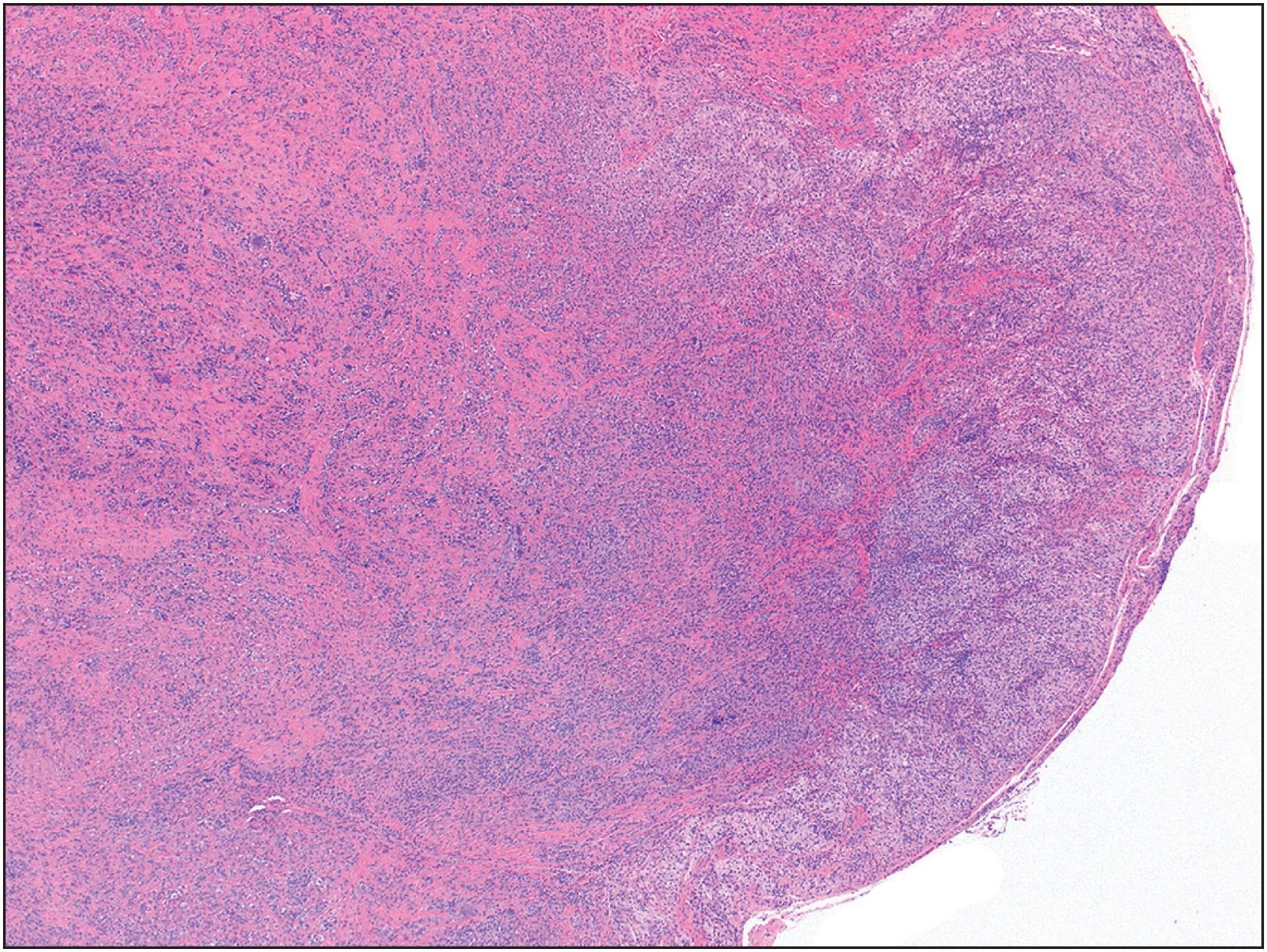
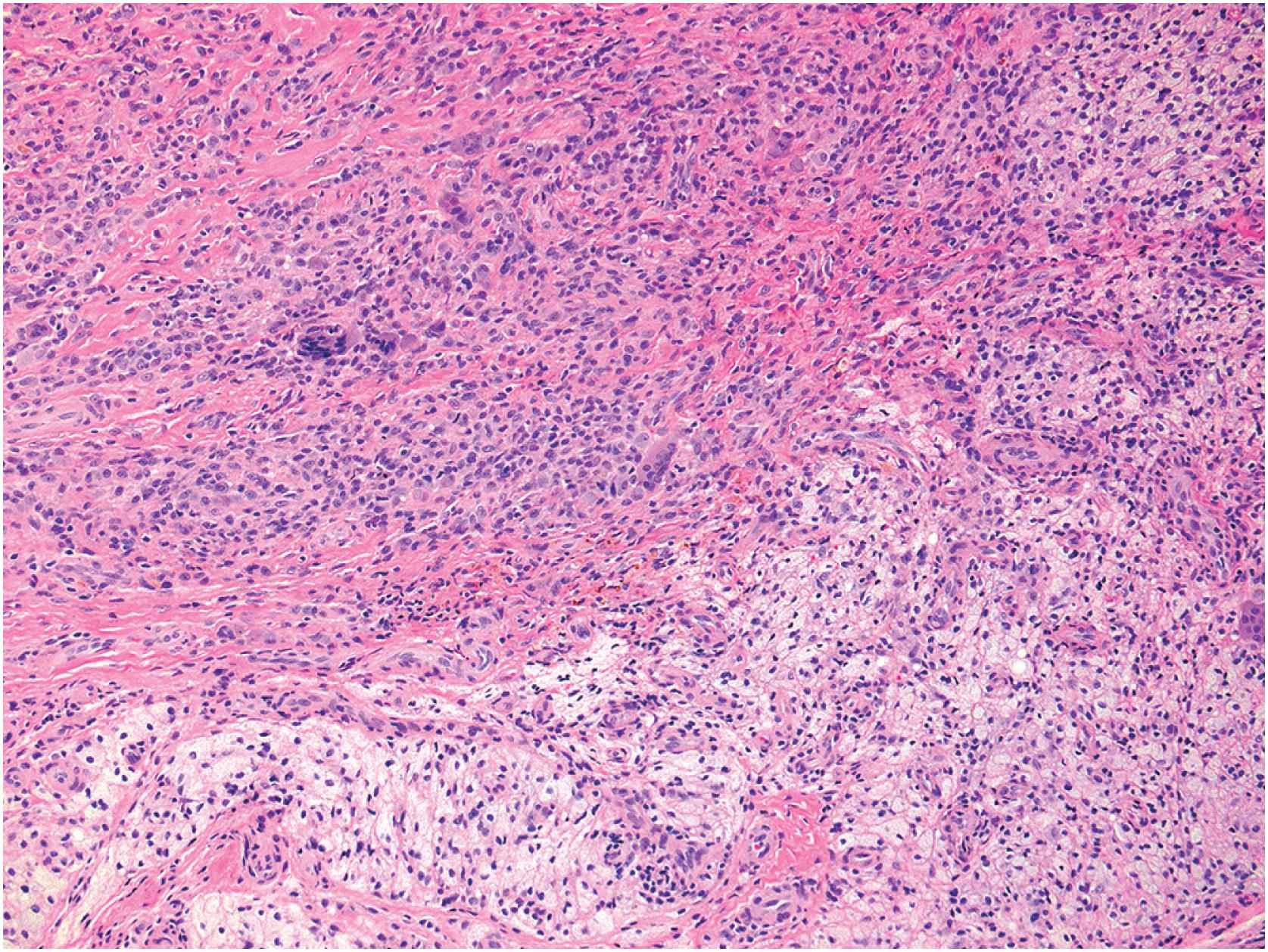
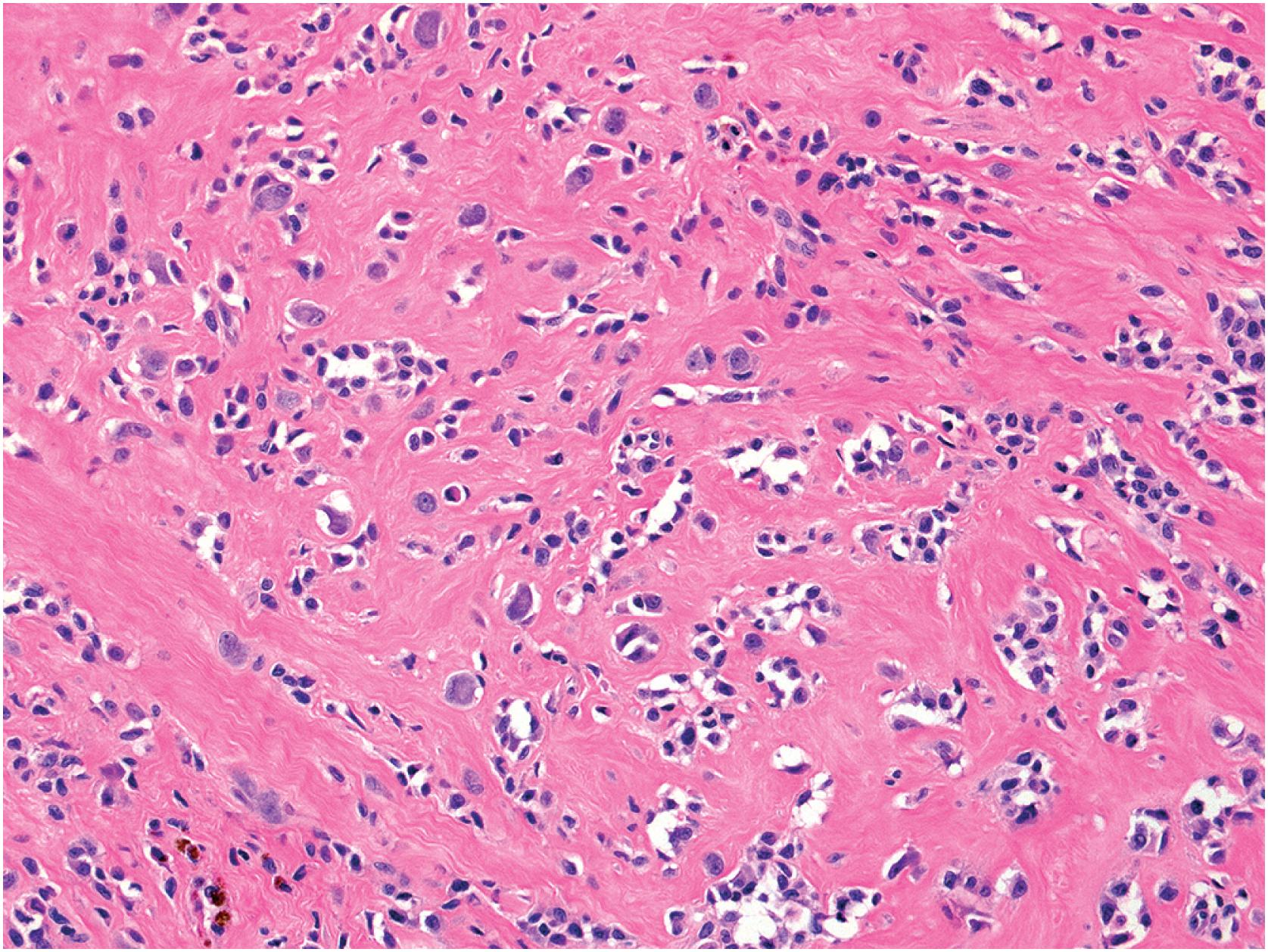
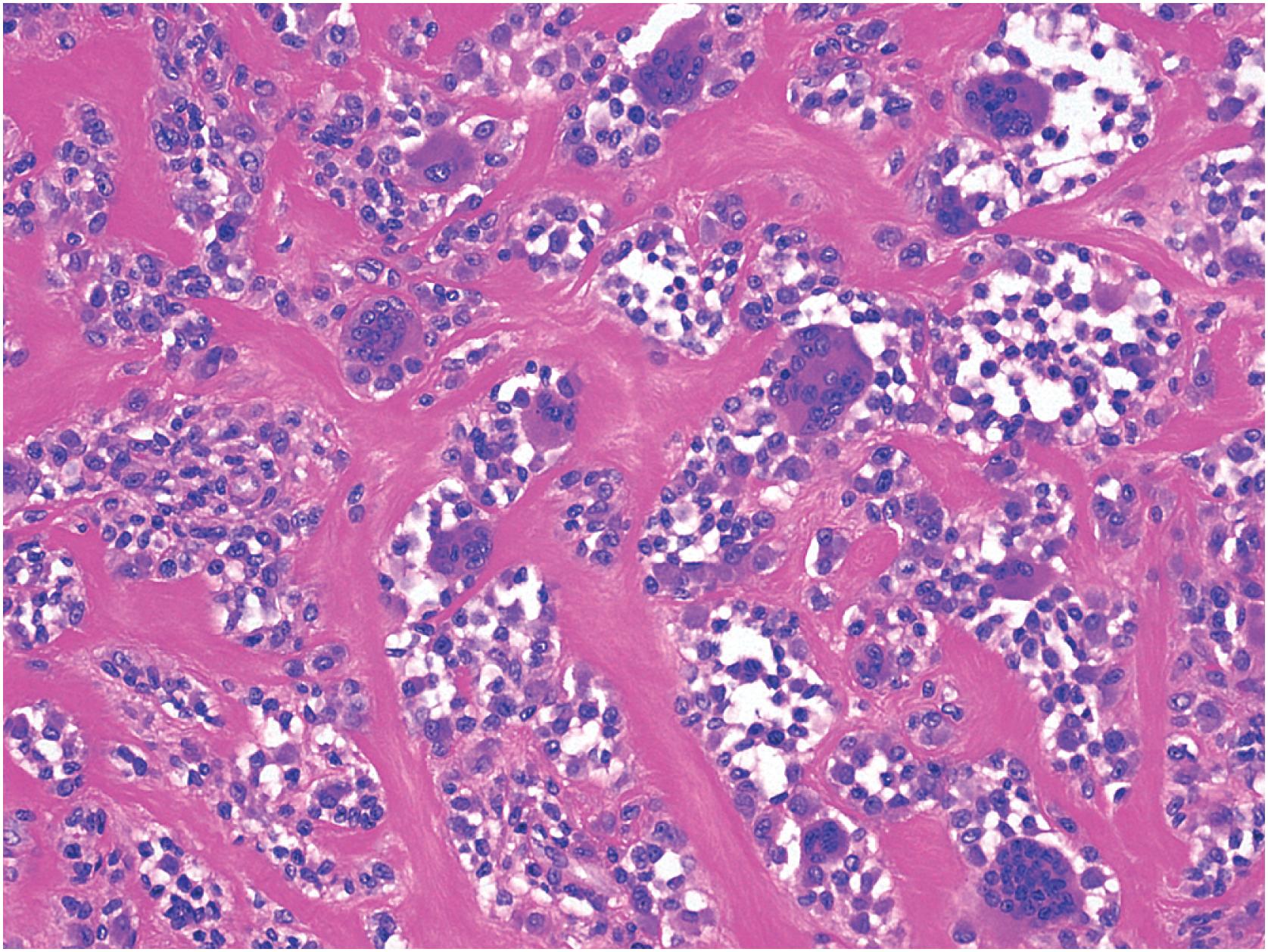
Immunohistochemically, the large monocytic cells thought to represent the neoplastic cells of TSGCT express clusterin and podoplanin, and often desmin ( Fig. 13.17 ). On occasion, a very large number of desmin- positive cells are seen; a potentially alarming feature. Non-neoplastic lesional macrophages and osteoclast-like giant cells also stain for CD68, while small non-neoplastic monocytes express CD163.
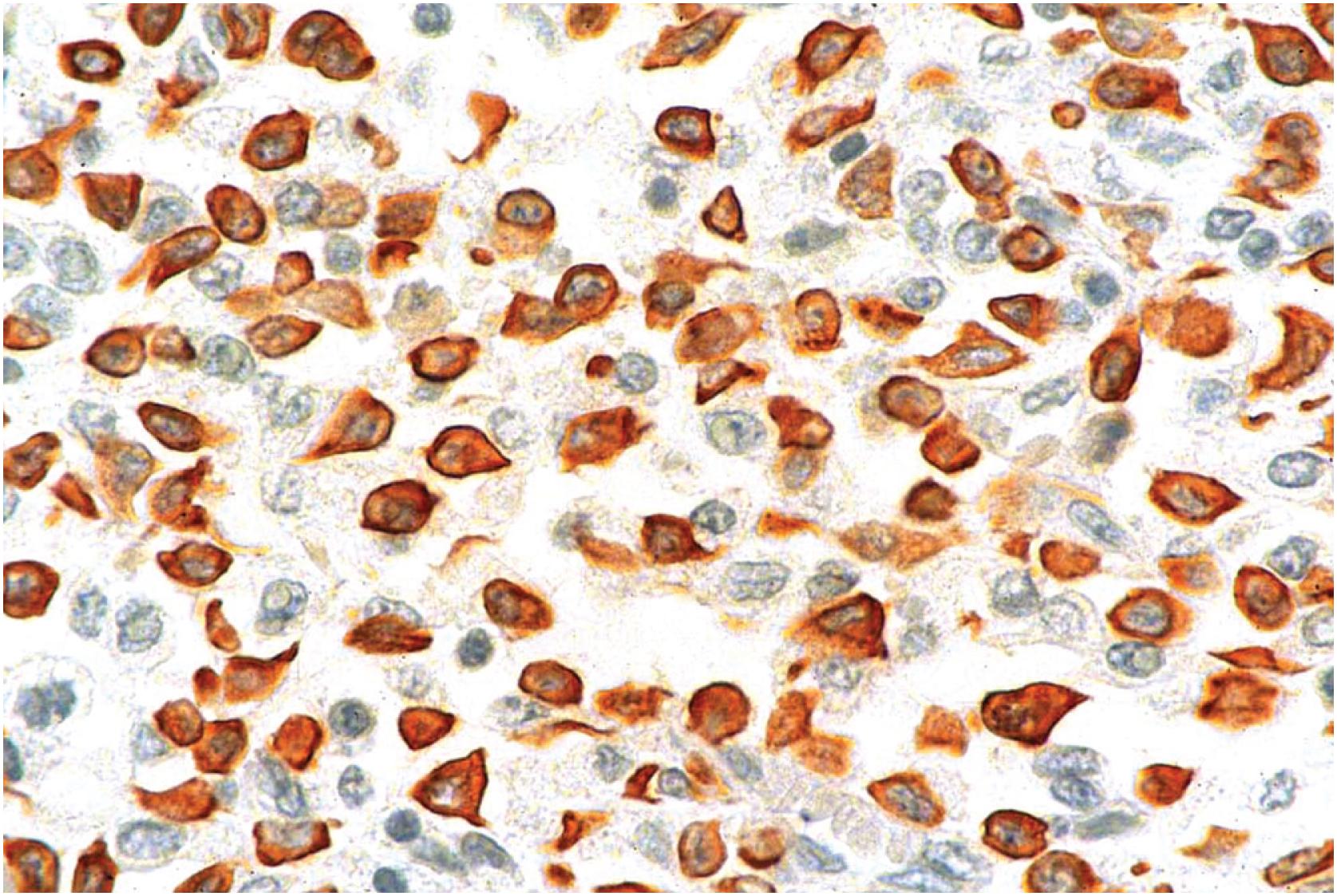
The neoplastic cells, typically comprising less than a quarter of the overall tumor cellularity, demonstrate deletions and rearrangements affecting colony stimulating factor 1 ( CSF1 ) on chromosome 1p13. These alterations result in the deletion of the 3’ untranslated region (UTR) of the CSF1 gene, which in turn is thought to dysregulate mRNA stability and translation, leading to protein overexpression and secretion of high levels of CSF1 protein by neoplastic cells. Consequently, CSF1 promotes survival and proliferation of the neoplastic cells in a paracrine or autocrine fashion, but also recruits and stimulates the differentiation of large numbers of non-neoplastic inflammatory cells expressing the receptor for CSF1. This phenomenon has been termed a landscape effect and is also observed in certain types of lymphomas. Demonstration of CSF1 mRNA expression by chromogenic in situ hybridization (CISH) is a promising new test for the diagnosis of TSGCT, but is not yet widely available outside of research settings.
The distinction between localized and diffuse TSGCT can be difficult to make on a small biopsy, and the histologic features have to be correlated with the clinical or radiographic findings. The diagnosis can also be difficult in cases where the needle biopsy samples areas of sclerosis or cellular areas devoid of multinucleated giant cells, or for tumors arising in extra-articular locations. Hemosiderotic synovitis may mimic TSGCT, but can be distinguished by the lower cellularity and absence of foamy histiocytes, osteoclast type giant cells, or nodularity. In general, diagnosis of an intra-articular diffuse TSGCT requires full thickness replacement of the subsynovial connective tissue by the mixed cell populations described above. Diffuse TSGCT containing large numbers of desmin-positive cells may be confused with rhabdomyosarcoma, particularly when a pseudoalveolar pattern of growth is present; absent expression of MyoD1 and myogenin and demonstration of clusterin expression should permit this distinction in all cases.
TSGCT is treated by surgical excision, preferentially with a cuff of normal tissue. Localized TSGCT has a local recurrence rate of 10%–20%. However, in diffuse TSGCT, tumor infiltration of the synovium makes complete excision difficult, resulting in a high local recurrence rate (>50%). Diffuse TSGCT that is refractory to repeated surgical excisions has been managed by low-dose radiation therapy in some cases. Targeted CSF1 inhibitors are an option for some patients with unresectable, highly symptomatic disease.
Hemosiderotic synovitis develops as a result of chronic intra-articular hemorrhage. This usually occurs in patients with a bleeding disorder, such as hemophilia, or receiving long term anti-coagulation, who are therefore predisposed to hemarthrosis, especially of the knees, elbows, and ankles (see Box 13.6 ). Hemosiderotic synovitis is rarely caused by a synovial hemangioma. Areas indistinguishable from hemosiderotic synovitis may also be seen in synovium affected by diffuse TSGCT.
Proliferation of synovial tissue accompanied by variable fibrosis caused by repeated episodes of intra-articular hemorrhage
Hemosiderotic synovitis occurs most commonly in the knee joints of patients with hemophilia
Other causes include recurrent joint trauma, long term anti-coagulation therapy, or bleeding from synovial hemangioma
Condition is rare
Predominantly affects male sex
Usually occurs in the second through fourth decades of life
Acute hemarthrosis presents with abrupt painful swollen joints
Chronic hemosiderosis results in chronic pain, swelling, and limitation in joint movement
Condition is benign, but when progressive and long standing, it results in severe degenerative arthritis of the affected joint
Prognosis is determined by the treatment of the underlying condition that is resulting in the recurrent hemorrhage
Chronic hemosiderotic synovitis may require joint replacement surgery because of the severe osteoarthritis
Patients with hemosiderotic synovitis report pain and stiffness of the involved joint. This is almost invariably caused by secondary osteoarthritis developing in association with chronic intra-articular hemorrhage.
Radiologic features that may be seen are juxtaepiphyseal osteoporosis and subperiosteal hemorrhage. During arthroscopy or surgery, diffuse discoloration of the synovium is present.
The synovium shows a diffuse brown-rust discoloration. In early hemosiderotic synovitis, fine villous projections are present, but the larger nodules and thickened fronds of diffuse TSGCT do not occur (see Box 13.7 ). In the later stages after chronic repeated hemorrhage, the synovium becomes thickened and opaque because of intrasynovial and subsynovial fibrosis. The adjacent articular cartilage may show a greenish-black discoloration.
Brown-rust discoloration of the synovial membrane
Early cases have thin villous excrescences that extend into the joint space
Established/chronic cases have a flattened atrophic appearance
Surface synovial cells are plump, cuboidal, and have abundant, readily-found intracytoplasmic hemosiderin granules
Hemosiderin-laden macrophages are present with the subsynovial connective tissue
Nodular thickening of the synovial membrane in the manner that occurs in diffuse tenosynovial giant cell tumor does not occur in hemosiderotic synovitis
Tenosynovial giant cell tumor
Synovial hemangioma
Metallosis
Ochronosis
The synovium is hyperplastic and contains yellow- brown hemosiderin granules. Within the subsynovial connective tissue, hemosiderin-laden macrophages are present, often in association with small blood vessels ( Fig. 13.18 ). Sheets of mononuclear synovial cells, lipid-laden cells, or multinucleated osteoclast-like giant cells, as seen in TSGCT are not a feature of hemosiderotic synovitis. The articular cartilage may show hemosiderin deposition within chondrocyte lacunae and necrosis of the chondrocytes.
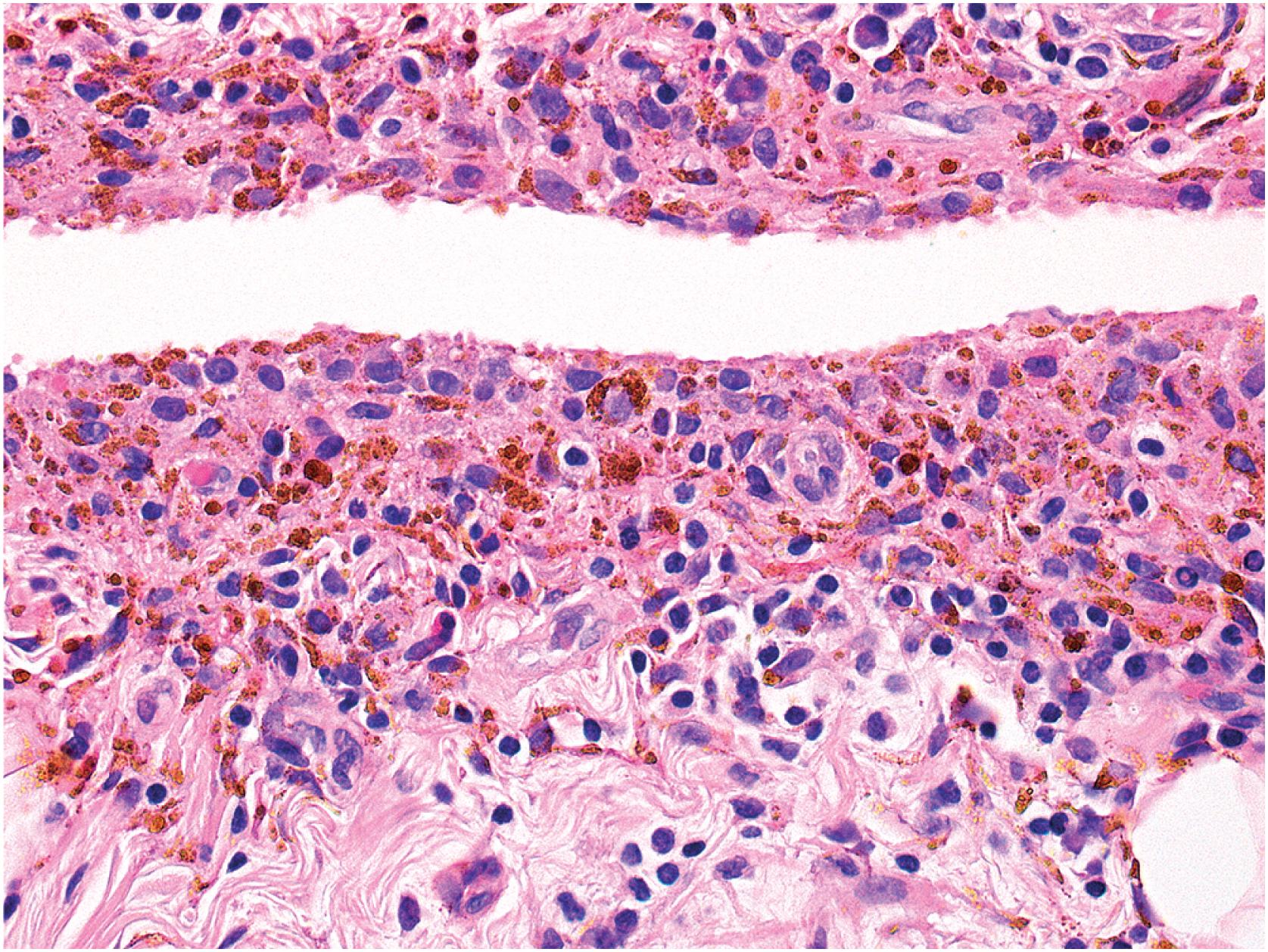
Become a Clinical Tree membership for Full access and enjoy Unlimited articles
If you are a member. Log in here